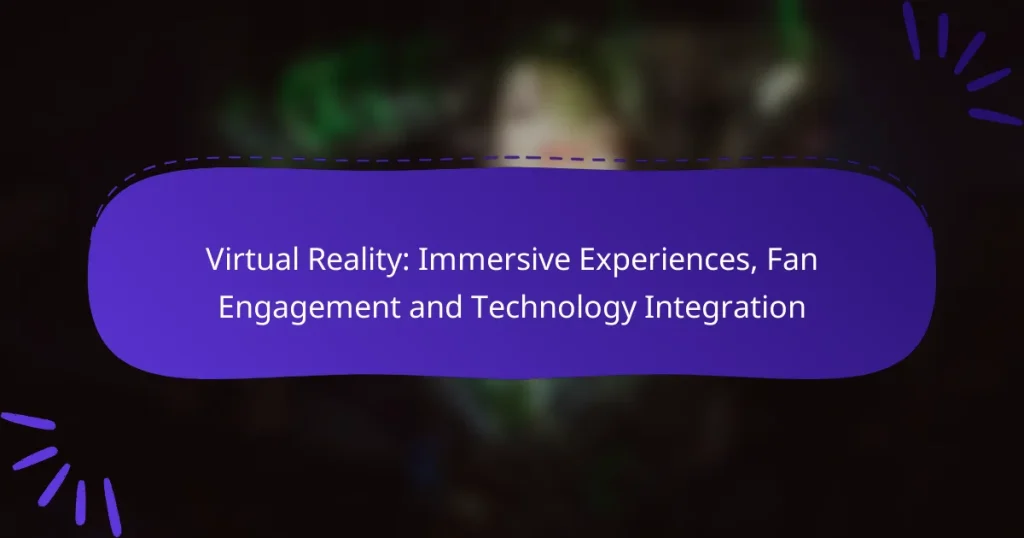Virtual Reality (VR) is revolutionizing fan engagement by providing immersive experiences that make spectators feel like active participants in the action. With platforms like Oculus Quest 2 and PlayStation VR2, fans can interact with their favorite teams and athletes in unprecedented ways, while technology integration enhances these experiences through innovative tools and interactive environments.
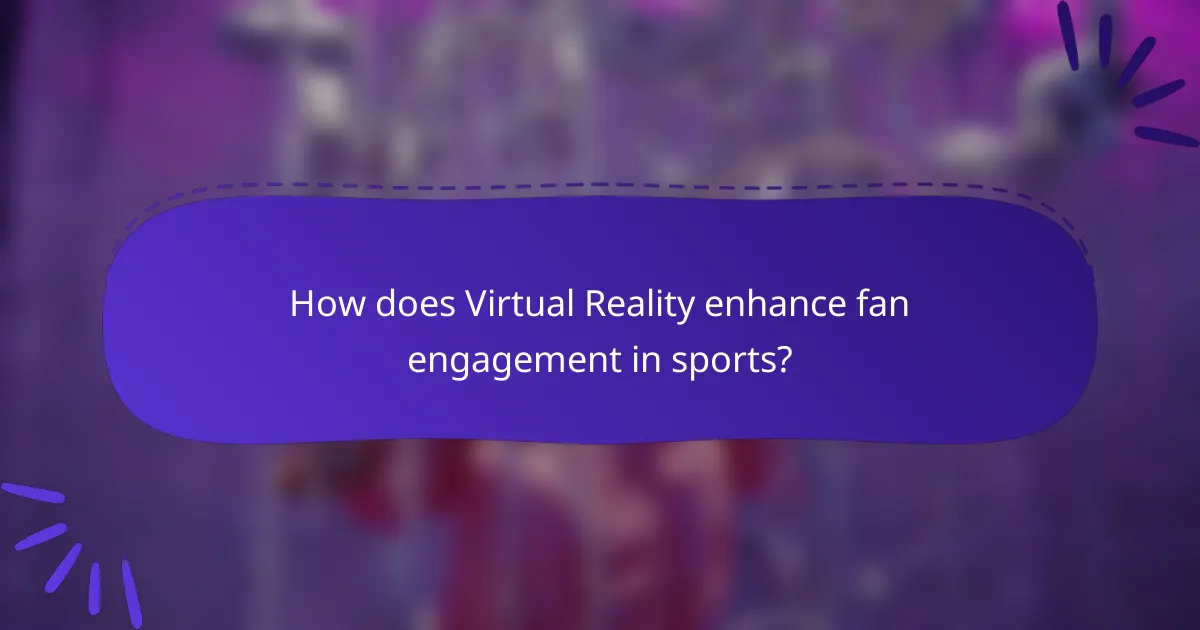
How does Virtual Reality enhance fan engagement in sports?
Virtual Reality (VR) significantly enhances fan engagement in sports by creating immersive experiences that allow fans to feel as though they are part of the action. Through various VR applications, fans can interact with their favorite teams and athletes in ways that were previously unimaginable.
Real-time game simulations
Real-time game simulations allow fans to experience live sports events from unique perspectives. By using VR technology, fans can step into the shoes of players, making strategic decisions and experiencing the game as if they were on the field. This interactive approach not only boosts engagement but also deepens fans’ understanding of the sport.
Interactive fan experiences
Interactive fan experiences through VR can include virtual stadium tours, skill challenges, and gamified content. Fans can participate in activities such as shooting hoops or scoring goals in a virtual environment, which fosters a sense of connection to the sport. These experiences can be tailored to different age groups and skill levels, making them accessible to a wider audience.
Virtual meet-and-greets with athletes
Virtual meet-and-greets allow fans to interact with their favorite athletes in a personal setting. Through VR platforms, fans can engage in Q&A sessions, receive autographs, or participate in exclusive events. This direct interaction enhances the emotional connection between fans and athletes, making the experience memorable.
Enhanced viewing options
VR offers enhanced viewing options that transform how fans watch games. Fans can choose their vantage point, whether it’s a courtside seat or a bird’s-eye view of the field. This flexibility allows for a more personalized viewing experience, catering to individual preferences and increasing overall satisfaction.
Community-building through VR platforms
Community-building is a key benefit of VR platforms, as they create virtual spaces where fans can gather and share their passion for sports. These platforms often host events, discussions, and social interactions, fostering a sense of belonging among fans. Engaging in these communities can lead to lasting friendships and a stronger connection to the sport.
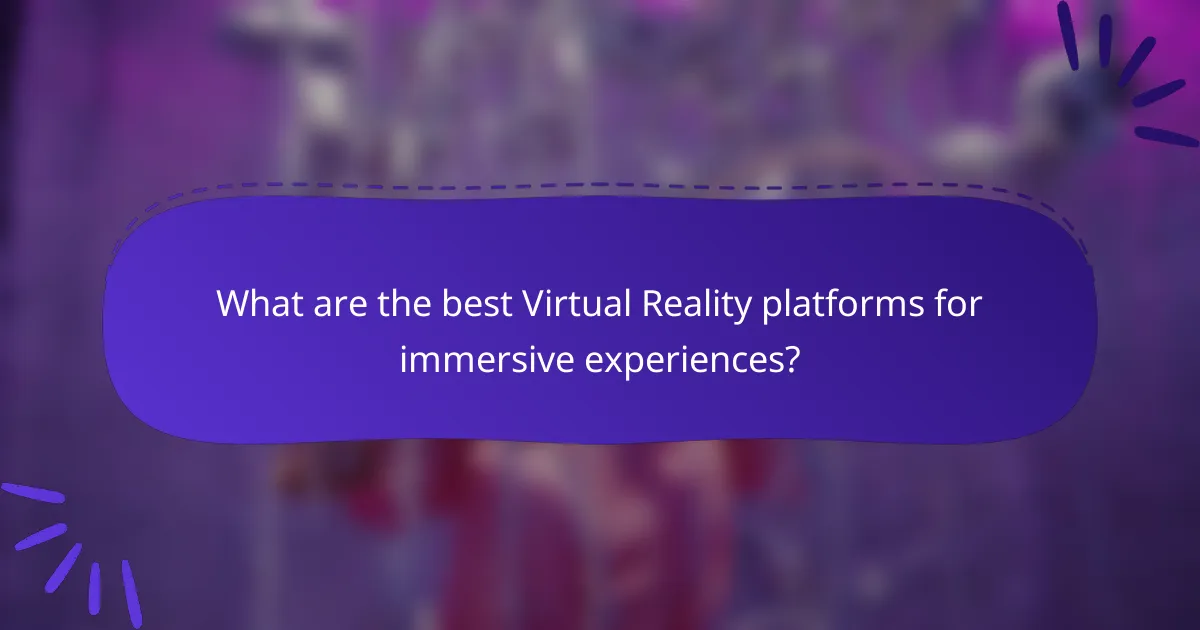
What are the best Virtual Reality platforms for immersive experiences?
The best virtual reality platforms for immersive experiences include Oculus Quest 2, HTC Vive Pro 2, PlayStation VR2, and Valve Index. Each platform offers unique features, performance levels, and content libraries that cater to different user preferences and budgets.
Oculus Quest 2
The Oculus Quest 2 is a standalone headset that provides a user-friendly experience without the need for a PC or console. It features a high-resolution display and a robust library of games and applications, making it ideal for casual and serious gamers alike.
With its wireless capabilities, users can enjoy freedom of movement, and the intuitive touch controllers enhance interaction within virtual environments. The price point is relatively affordable, often making it a top choice for newcomers to VR.
HTC Vive Pro 2
The HTC Vive Pro 2 is designed for high-end users seeking premium graphics and performance. It boasts a high-resolution display and wide field of view, which significantly enhances immersion in virtual environments.
This platform requires a powerful PC to operate, making it more suitable for dedicated gamers or professionals. The Vive Pro 2 also supports a range of accessories, allowing for customizable setups, but it comes with a higher price tag compared to other options.
PlayStation VR2
The PlayStation VR2 is tailored for PlayStation 5 users, offering seamless integration with the console. It features advanced haptic feedback and eye-tracking technology, which elevates the immersive experience to new levels.
This platform is particularly appealing for gamers who already own a PS5, as it leverages the console’s power to deliver stunning visuals and a diverse game library. However, it is limited to PlayStation titles, which may restrict options for some users.
Valve Index
The Valve Index is known for its high-quality build and exceptional tracking capabilities. It offers a wide field of view and high refresh rates, making it a favorite among enthusiasts who prioritize performance and realism.
This platform requires a compatible gaming PC and external base stations for tracking, which can complicate setup. The Valve Index is on the pricier side, but its advanced features justify the investment for serious VR users looking for the best experience available.
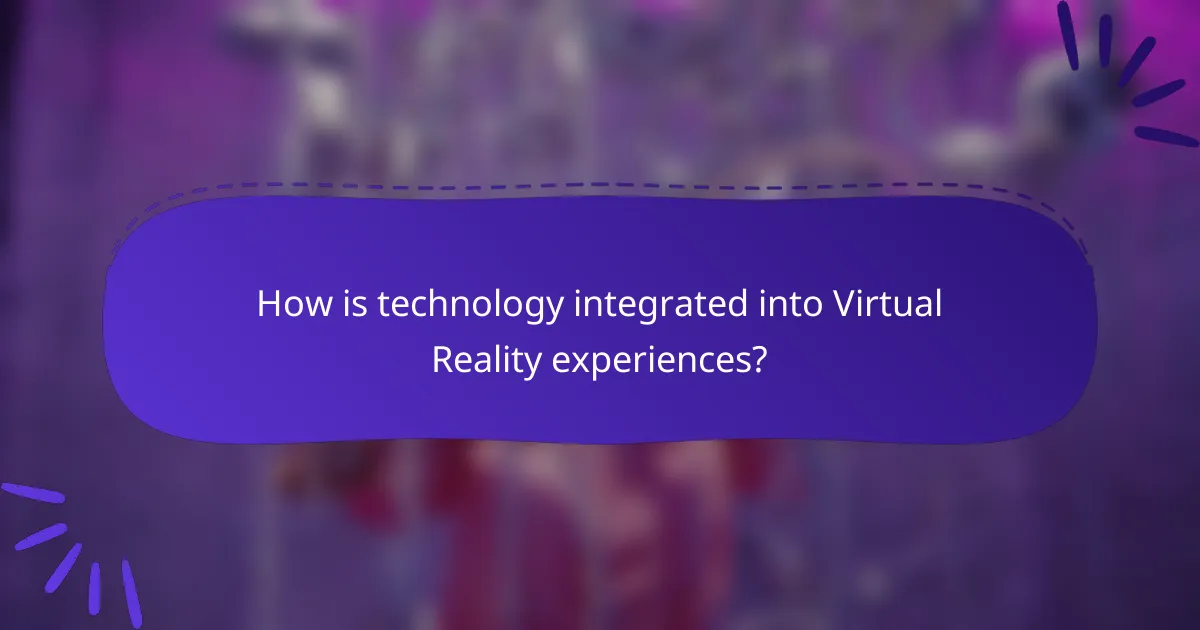
How is technology integrated into Virtual Reality experiences?
Technology integration in Virtual Reality (VR) experiences enhances immersion and user engagement through various innovative methods. By leveraging advanced tools and platforms, VR creates interactive environments that captivate users and facilitate social connections.
Use of 360-degree video
360-degree video technology allows users to experience a fully immersive environment by capturing video from all angles. This format enables viewers to look around freely, creating a sense of presence in the virtual space. For instance, travel companies use 360-degree videos to showcase destinations, allowing potential travelers to explore before booking.
When implementing 360-degree video, ensure high-quality production to avoid motion sickness and maintain viewer engagement. Consider using platforms like YouTube or Vimeo that support 360-degree content for wider accessibility.
Integration with social media
Integrating VR experiences with social media platforms enhances user interaction and sharing capabilities. Users can share their VR experiences in real-time, fostering community engagement and increasing exposure. For example, VR gaming platforms often allow players to broadcast their gameplay directly to social media channels.
To maximize this integration, create shareable content that encourages users to post their experiences. Utilize social media APIs to streamline sharing processes and enhance user connectivity.
AI-driven content personalization
AI-driven content personalization tailors VR experiences to individual user preferences, enhancing engagement and satisfaction. By analyzing user behavior and feedback, AI can adjust scenarios, difficulty levels, or content types to better suit each user. For example, fitness apps can modify workout environments based on user performance and preferences.
When implementing AI personalization, prioritize user privacy and data security. Clearly communicate how data will be used and provide options for users to customize their experience settings.
Cross-platform compatibility
Cross-platform compatibility ensures that VR experiences can be accessed on various devices, including VR headsets, smartphones, and PCs. This flexibility allows a broader audience to engage with the content, regardless of their hardware. For instance, many VR games are designed to work seamlessly across Oculus, HTC Vive, and PlayStation VR.
To achieve cross-platform compatibility, adhere to industry standards and utilize development tools that support multiple platforms. Regularly test your VR experiences on different devices to ensure consistent performance and user experience.
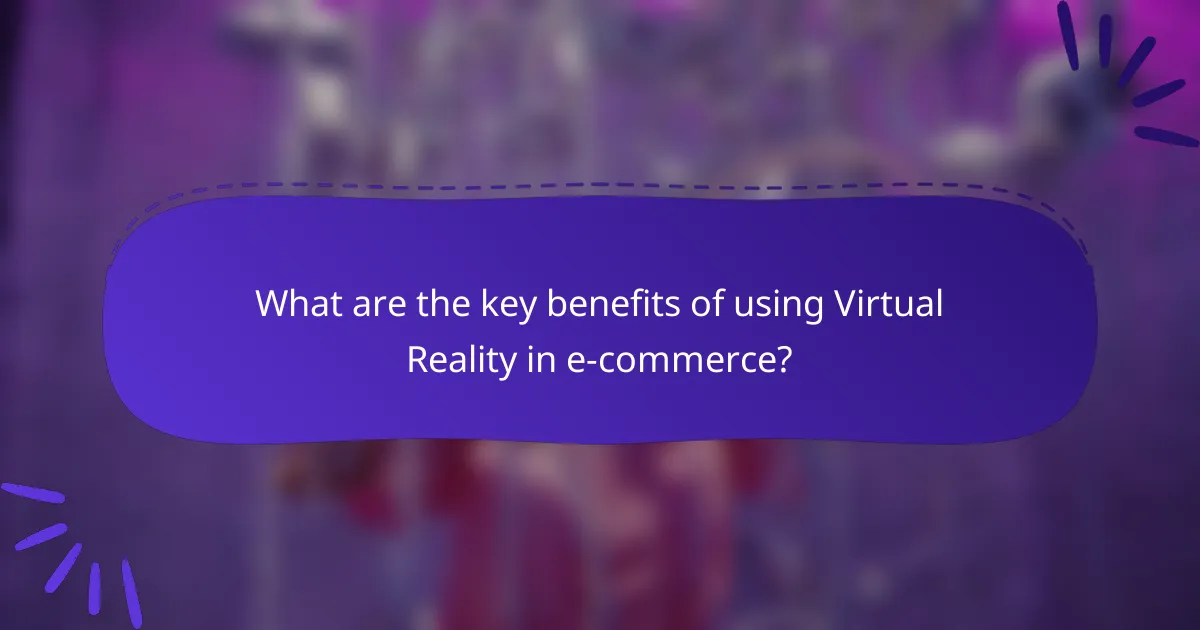
What are the key benefits of using Virtual Reality in e-commerce?
Virtual Reality (VR) enhances e-commerce by providing immersive experiences that improve customer engagement and decision-making. Key benefits include enhanced product visualization, virtual try-ons for apparel, and interactive product demonstrations, all of which can lead to higher conversion rates and customer satisfaction.
Enhanced product visualization
Enhanced product visualization allows customers to see products in a 3D environment, providing a more realistic view than traditional images. This technology can showcase items from various angles, helping consumers understand size, texture, and functionality better.
For example, furniture retailers can use VR to let customers visualize how a couch would look in their living room. This immersive experience can significantly reduce return rates, as customers feel more confident in their purchase decisions.
Virtual try-ons for apparel
Virtual try-ons enable customers to see how clothing items fit and look on them without physically trying them on. This technology uses augmented reality to overlay clothing on a customer’s image, allowing for a personalized shopping experience.
Brands like Warby Parker and Sephora have successfully implemented virtual try-ons, leading to increased sales and customer engagement. This approach can also help reduce the hassle of returns, as customers can make more informed choices.
Interactive product demonstrations
Interactive product demonstrations engage customers by allowing them to experience a product’s features in a virtual setting. This can include guided tours of a product’s functionalities or simulations of how a product works in real life.
For instance, tech companies can use VR to demonstrate the capabilities of gadgets, enabling potential buyers to interact with the product virtually. This hands-on experience can enhance understanding and interest, ultimately driving sales.
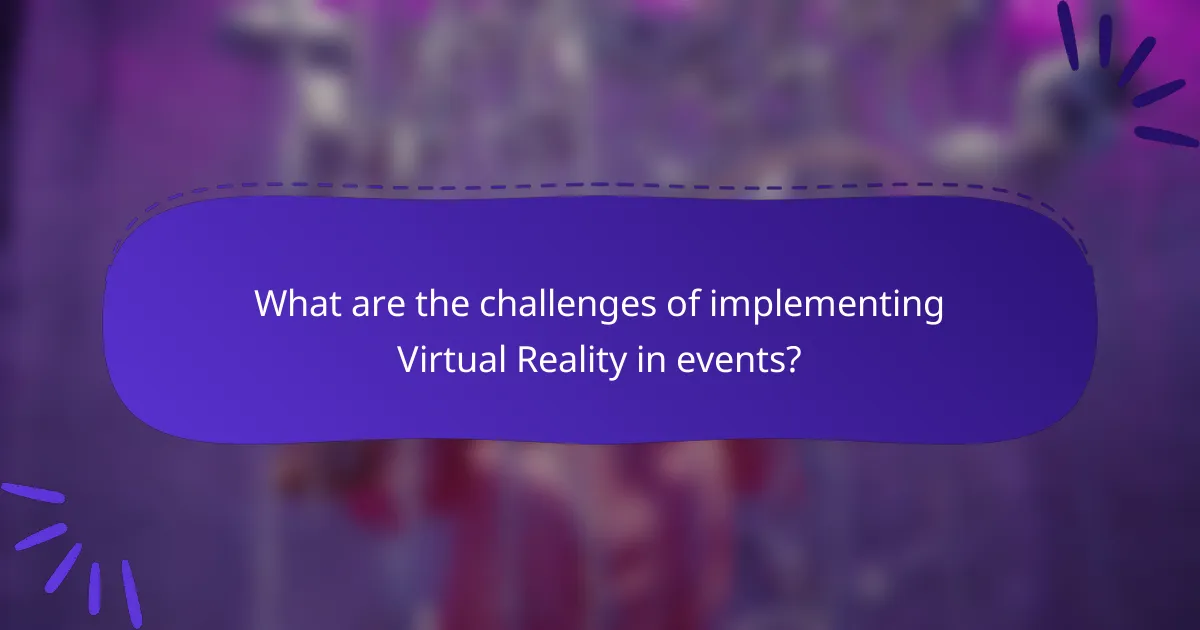
What are the challenges of implementing Virtual Reality in events?
Implementing Virtual Reality (VR) in events presents several challenges, including high setup costs, technical limitations, and user accessibility issues. Addressing these obstacles is crucial for successful integration and maximizing the immersive experience for attendees.
High setup costs
The initial investment for VR technology can be substantial, often running into thousands of dollars. This includes costs for hardware, software, and specialized equipment, which can deter smaller organizations from adopting VR for their events.
Additionally, ongoing expenses such as maintenance, updates, and technical support can add to the overall financial burden. Event planners should carefully evaluate their budget and consider potential ROI before committing to VR solutions.
Technical limitations
Technical challenges can hinder the effectiveness of VR at events. Issues such as latency, resolution, and compatibility with existing systems can affect the user experience. For instance, high latency can lead to motion sickness, which may discourage attendees from engaging with the technology.
Moreover, ensuring that the VR content is optimized for various devices and platforms is essential. Event organizers should conduct thorough testing to identify and resolve any technical issues prior to the event.
User accessibility issues
User accessibility is a significant concern when implementing VR in events. Not all attendees may have the physical ability or comfort level to use VR headsets, which can limit participation. Providing alternative options or experiences can help accommodate a wider audience.
Furthermore, ensuring that VR content is inclusive and user-friendly is vital. Event planners should consider offering training sessions or demonstrations to familiarize attendees with the technology, enhancing their overall experience.
